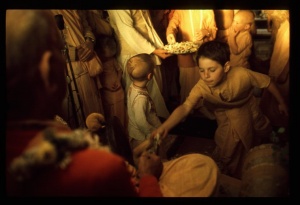CC Antya 2.31 (1975): Difference between revisions
(Vanibot #0027: CCMirror - Mirror CC's 1996 edition to form a basis for 1975) |
(Vanibot #0020: VersionCompareLinker - added a link to the Version Compare feature) |
||
| Line 2: | Line 2: | ||
<div style="float:left">'''[[Sri Caitanya-caritamrta (1975)|Śrī Caitanya-caritāmṛta (1975)]] - [[CC Antya (1975)|Antya-līlā]] - [[CC Antya 2 (1975)|Chapter 2: The Chastisement of Junior Haridāsa]]'''</div> | <div style="float:left">'''[[Sri Caitanya-caritamrta (1975)|Śrī Caitanya-caritāmṛta (1975)]] - [[CC Antya (1975)|Antya-līlā]] - [[CC Antya 2 (1975)|Chapter 2: The Chastisement of Junior Haridāsa]]'''</div> | ||
<div style="float:right">[[File:Go-previous.png|link=CC Antya 2.30 (1975)|Antya-līlā 2.30]] '''[[CC Antya 2.30 (1975)|Antya-līlā 2.30]] - [[CC Antya 2.32 (1975)|Antya-līlā 2.32]]''' [[File:Go-next.png|link=CC Antya 2.32 (1975)|Antya-līlā 2.32]]</div> | <div style="float:right">[[File:Go-previous.png|link=CC Antya 2.30 (1975)|Antya-līlā 2.30]] '''[[CC Antya 2.30 (1975)|Antya-līlā 2.30]] - [[CC Antya 2.32 (1975)|Antya-līlā 2.32]]''' [[File:Go-next.png|link=CC Antya 2.32 (1975)|Antya-līlā 2.32]]</div> | ||
{{CompareVersions|CC|Antya 2.31|CC 1975|CC 1996}} | |||
{{RandomImage}} | {{RandomImage}} | ||
==== TEXT 31 ==== | ==== TEXT 31 ==== | ||
<div class="verse"> | <div class="verse"> | ||
: | :'gaura-gopāla mantra' tomāra cāri akṣara | ||
:aviśvāsa chāḍa, yei kariyācha | :aviśvāsa chāḍa, yei kariyācha antara" | ||
</div> | </div> | ||
| Line 25: | Line 24: | ||
<div class="translation"> | <div class="translation"> | ||
"You are chanting the Gaura-gopāla mantra composed of four syllables. Now please give up the doubts that have resided within you." | |||
</div> | </div> | ||
| Line 32: | Line 31: | ||
<div class="purport"> | <div class="purport"> | ||
Śrīla Bhaktivinoda Ṭhākura explains the Gaura-gopāla mantra in his Amṛta-pravāha-bhāṣya. Worshipers of Śrī Gaurasundara accept the four syllables gau-ra- | Śrīla Bhaktivinoda Ṭhākura explains the Gaura-gopāla mantra in his Amṛta-pravāha-bhāṣya. Worshipers of Śrī Gaurasundara accept the four syllables gau-ra-aṇ-ga as the Gaura mantra, but pure worshipers of Rādhā and Kṛṣṇa accept the four syllables rā-dhā kṛṣ-ṇa as the Gaura-gopāla mantra. However, Vaiṣṇavas consider Śrī Caitanya Mahāprabhu nondifferent from Rādhā-Kṛṣṇa (śrī-kṛṣṇa-caitanya rādhā-kṛṣṇa nahe anya). Therefore one who chants the mantra Gaurāṅga and one who chants the names of Rādhā and Kṛṣṇa are on the same level. | ||
</div> | </div> | ||
Latest revision as of 00:18, 27 January 2020

A.C. Bhaktivedanta Swami Prabhupada
TEXT 31
- 'gaura-gopāla mantra' tomāra cāri akṣara
- aviśvāsa chāḍa, yei kariyācha antara"
SYNONYMS
gaura-gopāla mantra—the Gaura-gopāla mantra; tomāra—your; cāri akṣara—composed of four syllables; aviśvāsa chāḍa—give up your doubts; yei—which; kariyācha antara—you have kept within your mind.
TRANSLATION
"You are chanting the Gaura-gopāla mantra composed of four syllables. Now please give up the doubts that have resided within you."
PURPORT
Śrīla Bhaktivinoda Ṭhākura explains the Gaura-gopāla mantra in his Amṛta-pravāha-bhāṣya. Worshipers of Śrī Gaurasundara accept the four syllables gau-ra-aṇ-ga as the Gaura mantra, but pure worshipers of Rādhā and Kṛṣṇa accept the four syllables rā-dhā kṛṣ-ṇa as the Gaura-gopāla mantra. However, Vaiṣṇavas consider Śrī Caitanya Mahāprabhu nondifferent from Rādhā-Kṛṣṇa (śrī-kṛṣṇa-caitanya rādhā-kṛṣṇa nahe anya). Therefore one who chants the mantra Gaurāṅga and one who chants the names of Rādhā and Kṛṣṇa are on the same level.